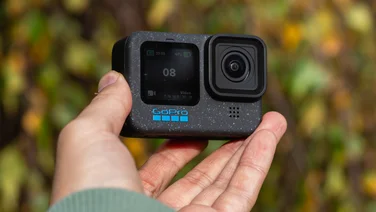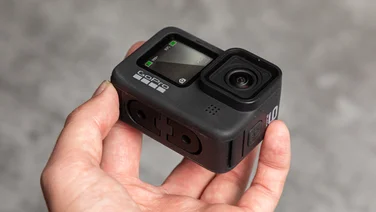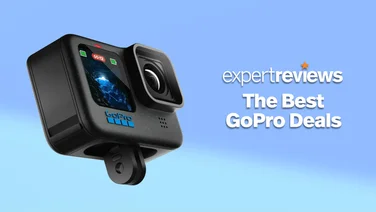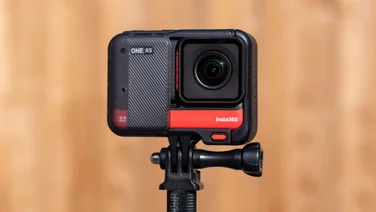To help us provide you with free impartial advice, we may earn a commission if you buy through links on our site. Learn more



















- Waterproof at up to 10m
- Excellent video stabilisation
- Great audio quality
- Doesn’t shoot 4K
- Image quality is merely good
- No GPS
The original GoPro Hero made its mark back in 2014, boasting Full HD recording at 30fps. Now the all-new 2018 Hero boosts that to 1440p at 60fps – and like other modern GoPro cameras, it’s also waterproof up to 10m, with no need for a special case. That makes it an appealingly versatile camera; the only question is how it stacks up against today’s rivals.
READ NEXT: GoPro Hero 5 Black review: Now free if you bought a Karma
GoPro Hero (2018) review: What you need to know
The new Hero looks almost exactly like its more expensive siblings, the Hero5 and Hero6 Black – and like them it has a 2in touchscreen display, a waterproof body, built-in video stabilisation and a nifty voice control feature for hands-free operation.
It’s lacking a few features, though. While the Hero5 and Hero6 both offer 4K recording, the new Hero only goes up to 1,920 x 1,440 (albeit at a smooth 60fps). There’s no GPS either, and you don’t get the digital zoom, manual exposure or image controls of the Hero6,
Stills capabilities have also been scaled back. The 10-megapixel sensor has a maximum 10fps burst mode, which is quite a step down from the 12-megapixel, 30fps capabilities of the other two cameras, and there’s no HDR option.



















READ NEXT: Best action cameras – our pick of the best action cams for 4K recording, running, cycling and more
GoPro Hero (2018) review: Price and competition
At £200, the 2018 Hero isn’t exactly cheap, but it comes with a good set of accessories: inside the package, you’ll find a mounting frame, curved and flat adhesive mounts, a mounting buckle, and a USB-C Cable. Buy it through the GoPro store and you’ll also get a 32GB SanDisk Extreme microSD card thrown in for free.
There are several 4K-capable rivals available at around this price, however. You can get the incredible Yi 4K+ for £250, the GoPro Hero5 Black for £263 – or the Hero5 Session for just £144. Just note that the Yi 4K+ isn’t waterproof without an external case, and the Hero5 Session doesn’t have a display.
GoPro Hero (2018) review: Design and features
As we’ve noted, the new Hero looks all but identical to its siblings; it has exactly the same 62.3 x 44.9 x 33mm case, as well as a USB-C “supercharger” port, a micro-HDMI port for video output and a removable battery.



















The power and shutter buttons remain in their familiar places – on the right-hand side and top right, respectively – while the 2in touchscreen display dominates the back, and there’s also a little front-facing LCD data display. As usual, there’s no tripod thread on the underside, but an adaptor can be had online for as little as £5.



















While all of this may smack of a lack of imagination of GoPro’s part, it means that, just like its upmarket siblings, the Hero can be submerged in water up to an impressive depth of 10m without needing an external case. This is a big advantage over most competitors: a case can make it awkward to operate the camera, and tends to affect the overall video and audio quality. And if you’re looking to take the camera to greater depths, you can use any of the diving accessories already available for the Hero5 or Hero6.
READ NEXT: GoPro Hero 6 Black review: The best action camera is now a little cheaper
GoPro Hero (2018) review: Software
I found it perfectly easy to connect the camera to the GoPro app (formerly known as Capture) on my phone. The one caveat is that the Hero only works over 2.4GHz Wi-Fi – the 5GHz band isn’t supported – so file transfers aren’t quite as quick as they could be.



















The app itself is intuitive and easy to get your head around. You can change camera settings by tapping the cog on the top-right hand side, snap a picture, record a video and download footage with ease. The app also makes it easy to manage your microSD card’s storage. And once you’ve got your clips, you can switch to the Quik app to easily edit them together into a shareable video – great for Instagrammers and vloggers.
READ NEXT: GoPro Hero 5 Session review: Size doesn’t matter
GoPro Hero (2018) review: Performance
The 2018 Hero records H.264 video at resolutions up to 1,920 x 1,440 at 60fps. The bit rate is set at 30Mbits/sec for 1080p/60fps video and 45Mbits/sec for 1440p/60fps footage, so a minute of Full HD video takes up around 225MB of space, while switching up to 1440p uses around 340MB.



















These aren’t particularly impressive numbers: the Yi 4K+ records 1080p/60fps video at 60Mbits/sec, and 1440p footage at 75Mbits/sec, which allows it to capture more fine detail. The Hero6 Black meanwhile uses the more advanced H.265 codec to cram more detail into the same number of bits.
Even so, the Hero’s video quality is rather good. In my tests, I found videos had natural-looking colours, and the camera’s sensor adjusted deftly to different exposure levels. Predictably, low light scenes did get a bit grainy – and since the Hero lacks the Hero6’s “ProTune” settings, you can’t lock the ISO or adjust the camera’s shutter speed to reduce the effect. Even so, it compares well to cheapie action cameras, which often suffer from oversaturation and struggle with high-contrast scenes.



















I was also impressed by the Electronic Images Stabilisation (EIS): when I jogged along with the camera in hand, the recorded video showed barely any shaking. It’s so good you won’t need a gimbal for most applications – again, not something that can be said of many low-cost cameras.



















And audio quality is very good indeed. The Hero has the same three-microphone array and smart audio processing capabilities as the Hero5 and Hero6 Black, and the benefits are easy to hear: I’d go as far as to say that the GoPro Hero is the best sounding action camera available at this price.
Stills photography is less of a triumph. As you can see from the image below, photos come out looking rather dull and lacking in fine detail. There’s no option to shoot in RAW either, which limits what you can do to post-process the results. I’d suggest sticking to your smartphone for photography.



















The camera’s overall responsiveness is good, though; the touchscreen works well, as do the voice commands, which allow you to (for example) start recording simply by saying the appropriate instruction out loud. A full list of what you can say to the Hero can be found on GoPro’s website.
READ NEXT: Yi 4K+ review: A GoPro Hero6 action camera rival
GoPro Hero (2018) review: Verdict
Despite the name, the new GoPro Hero isn’t an aspirational camera: if you’re looking for 4K recording, advanced video controls or the very best possible image quality, you’ll be disappointed. And don’t forget there’s no GPS either – if you want to record your car’s G-Force, you’ll need to get the Hero5 or Hero6 Black.
Yet the Hero has undeniable strong points. It’s the only camera under £200 to offer waterproofing without the need of an external case, and while the video quality might not be quite best-in-class, its great exposure and excellent stabilisation go a long way to make up for that.
In short, if you’re not bothered about extreme resolutions and technical settings, but just want a versatile action camera at a sensible price, the new GoPro might just be the Hero you’ve been waiting for.









